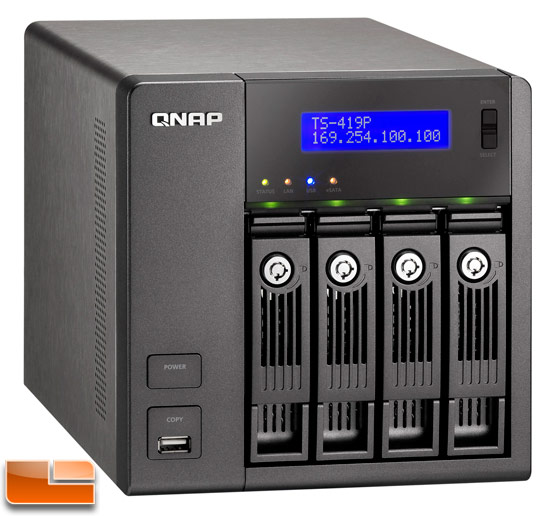QNAP TS-419P Turbo NAS 4-Bay Network Storage Review
Introducing the QNAP TS-419P Turbo NAS
My home based network is a mix of two windows based workstations (XP and Windows 7), two XP laptops and two Linux servers (Redhat 5 and Fedora Core 10). External storage on these systems has always been on my todo list and a simple solution would be to add a network attached storage device or NAS. Up to this point, every time I looked at a NAS, they always seemed poorly made or way too expensive for a home based system. Recently I was asked to review the QNAP TS-419P and was hopeful that this system would fit my storage needs, be priced right and have the quality I have been looking for in a NAS.

There are two main reasons for me wanting a network attached storage device at home. One is for backing up the various computers on my network and the other is a centralized storage area for streaming media in my house. I wanted my NAS to have at least RAID 5 capability and the ability to expand in the future. After reading some of the features such as Advanced RAID Management with Hot-swap Design, Online RAID Capacity Expansion and S.M.A.R.T & Advanced HDD Health Scanning (HHS), I realized that this system would do what I wanted and a whole lot more.

After reviewing the hardware specifications I noticed that the system is shipped without hard drives. The max hard drive size this system can hold is 4 x 2 TB for a total of 8 TB. At this time, 2 TB drives are still a little pricey, but it good to know that I can expand when the price of those drives come down. After receiving the TS-419P, I went down to my local Frys electronics store and was able to get a great deal on four Seagate Barracuda 7200.12 500GB drives. Four 500 GB drives with RAID 5 would give me about 1.3 TB of disk space, not a bad start.
Lets take a look at the hardware and software specifications before we move to the installation and configuration of the NAS.
Hardware Specifications:
CPU
Marvell 6281 1.2GHz
DRAM
512MB DDRII RAM
Flash Memory
16MB
HDD
4 x 3.5″ or 2.5 SATA I/II HDD
NOTE:
- The system is shipped without HDD.
- For the HDD compatibility list, please visit http://www.qnap.com/pro_compatibility.asp
HDD Tray
4 x hot-swappable and lockable tray
LAN
Port 2 x Gigabit RJ-45 Ethernet port
LED Indicators
Status, LAN, USB, eSATA, HDD 1, HDD 2, HDD 3, HDD 4
USB
4 x USB 2.0 port (Front: 1; Back: 3)
Supports USB printer, disk, pen drive, USB hub, and USB UPS, etc.eSATA
2 x eSATA port (Back)
Buttons
Power button, USB one-touch-backup button, reset button
LCD panel
Mono-LCD display with backlight and buttons for configuration
Alarm Buzzer
System warning
Form Factor
Tower
Dimensions
177(H) x 180(W) x 235(D) mm
6.97(H) x 7.09(W) x 9.25(D) inchWeight
Net weight: 3 Kg (6.61 lbs)
Gross weight: 4.6 Kg (10.14 lbs)Sound Level (dB)
W/o HDD installed: 33 dB
Stand by: 33.2 dB
In operation: 35.1dB
(Background: 25.5 dB)Power Consumption (W)
Sleep mode: 11W
In operation: 26W
(with 4 x 500GB HDD installed)Temperature
0~40C/ 32~104F
Humidity
0~95% R.H.
Power Supply
Input: 100-240V AC, 50/60Hz, Output: 12V DC, 10A, 120W
Secure Design
K-lock security slot for theft prevention
Fan
1 x quiet cooling fan (9 cm, 12V DC)
Software Specifications:
Operating System
Linux-embedded system
Networking
TCP/IP, DHCP Client, DHCP Server, CIFS/SMB, AFP, NFS, HTTP, HTTPS, FTP, DDNS, NTP
Multi-IP setting
Gigabit Jumbo Frame
Port Trunking
– Balance-rr (Round-Robin)
– Active Backup
– Balance XOR
– Broadcast
– IEEE 802.3ad
– Balance-tlb (Adaptive Transmit Load Balancing)
– Balance-alb (Adaptive Load Balancing)Network Service Discovery (UPnP & Bonjour)
File System
EXT3 (Internal/ external HDD)
EXT4 (Internal/ external HDD)
FAT (External HDD)
NTFS (External HDD)
Supported Operating Systems
Microsoft Windows 98/ ME/ NT/ 2000/ XP/ 2003/
Vista/ Windows 7 (32bit & 64bit) Mac OS X
Linux and UNIXDisk Management
Sngle disk, RAID 0 (Disk Striping), RAID 1 (Disk Mirroring), RAID 5, RAID 5+ Hot spare, RAID 6, and JBOD (Linear Disk Volume)
Multiple RAID
Online RAID Capacity Expansion
Online RAID Level Migration
RAID Recovery
Bitmap support for faster RAID rebuild (RAID 1/5/6)Disk usage status management
Check disk (Check Linux file system)
HDD S.M.A.R.T.
Bad blocks scan
Built-in iSCSI target service
Virtual Disk Drive (VDD) for storage expansion (max. 8 Volumes)
User Management
User quota management (per user)
Windows AD
User account management (max. 4,096 users)
User group management (max. 512 groups)
Batch creating users
File System Management
Network share management (max. 512 shares)
Network volume status management
Share folder level ACL support
Hide share folder on Windows network
Unicode support
Journaling file system
Web File Manager
System Tools
E-mail alert (SMTP authentication)
SMS alert
HDD standby mode
Disk usage alert
Automatic power on after power loss
System firmware upgrade
SNMPBack up, restore, reset system settings
Smart fan setting
Configurable management port
Policy-based unauthorized IP blocking
Secure remote login by SSH connection
Remote login by Telnet connection
USB, SNMP UPS support
Schedule power on/ off (max. 15 settings)
Network recycle bin
Import SSL certificate
Real-time System Resource Monitor
LCD
When the system is ready, users can check or configure the IP settings, physical disk info, volume info, system info, shut down or reboot the NAS, etc.
Event Logs
Complete system logs (file level): system events management, connection logs, current connection of on-line users
Multilingual Support
English, Traditional Chinese, Simplified Chinese, Japanese, Korean, French, German, Italian, Spanish, Russian, Swedish, Norwegian, Finnish, Danish, and Polish
Backup Management
PC-client backup software-NetBak Replicator: Instant/ Schedule/ Auto-sync backup
Remote replication supports Rsync
Encrypted remote replication
One touch USB copy for different destination folders
Data backup to external storage device
Multi-browser support
Internet Explorer 7 & 8
Safari 3 & 4
Firefox 3
Google Chrome

Comments are closed.